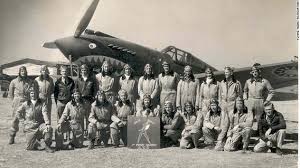The Flying Tigers, known officially as the American Volunteer Group (AVG), were a group of American pilots who fought alongside Chinese forces against Japan during World War II. They played a crucial role in defending China and Burma (now Myanmar) from Japanese aggression. Here’s an overview of their history and significance:
Background
- Sino-Japanese Conflict:
- Japan invaded China in 1937, leading to the Second Sino-Japanese War.
- China’s air force was outmatched by Japan’s superior aircraft and pilots.
- Claire Lee Chennault:
- A retired U.S. Army Air Corps officer, Chennault was recruited by Chinese leader Chiang Kai-shek to help modernize China’s air force.
- Chennault developed a strategy to counter Japan’s air superiority using innovative tactics.
- Formation of the Flying Tigers:
- In 1941, Chennault recruited American pilots and ground crew to form the American Volunteer Group (AVG).
- The AVG was funded by the Chinese government and operated under the guise of a civilian organization to avoid violating U.S. neutrality laws.
Key Achievements
- Combat Success:
- The Flying Tigers flew Curtiss P-40 Warhawk aircraft, which were less advanced than Japanese planes but were used effectively with Chennault’s tactics.
- They achieved a remarkable kill ratio, destroying nearly 300 Japanese aircraft while losing only 14 of their own in combat.
- Defense of Burma Road:
- The AVG protected the Burma Road, a critical supply route for Allied forces in China.
- They also defended key cities like Kunming and Chungking from Japanese bombing raids.
- Morale Boost:
- The Flying Tigers’ successes provided a much-needed morale boost to Chinese forces and civilians during a difficult period of the war.
Legacy
- Integration into U.S. Army Air Forces:
- In July 1942, the AVG was disbanded and absorbed into the U.S. Army Air Forces as the 23rd Fighter Group.
- Many of the original Flying Tigers continued to serve in the new unit.
- Symbol of Sino-American Cooperation:
- The Flying Tigers became a symbol of friendship and cooperation between the United States and China during World War II.
- Their legacy is still celebrated in both countries today.
- Memorials and Honors:
- Numerous memorials, museums, and monuments honor the Flying Tigers in the U.S. and China.
- In 2021, China commemorated the 80th anniversary of the Flying Tigers’ formation, highlighting their enduring significance.
Interesting Facts
- The name “Flying Tigers” comes from the shark-faced nose art painted on their P-40s, which was inspired by the teeth of a tiger.
- The AVG’s emblem featured a winged tiger, symbolizing their ferocity and agility in combat.
- Despite their short existence (less than a year), the Flying Tigers left an indelible mark on military aviation history.
The Flying Tigers remain a powerful example of courage, innovation, and international cooperation during one of the darkest periods of the 20th century. Let me know if you’d like more details!















